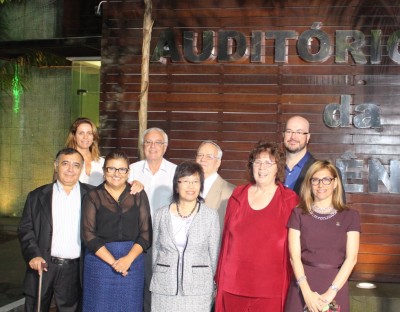A Richly Deserved Retirement; a Job Well Done
Published: 1 July 2014
June 30, 2014, marks another key milestone in the progress and evolution of the ARM Climate Research Facility. After 20 years of leadership, Wanda Ferrell, DOE Program Director for the ARM Facility, is retiring.
Under her strong and astute guidance, what began in 1989 with a 10-year vision as an observational testbed network is now entering its third decade and going strong, preparing for a strategic reconfiguration to support climate modeling well into the future. Jim Mather, ARM Technical Director at Pacific Northwest National Laboratory, noted this is due in large part to Ferrell’s endless interest in all things to do with the Facility.
“Her dedication to ARM expressed itself in her frequent meetings with the ARM Infrastructure Management Board, her very detailed knowledge of the full range of the facility, visits to remote sites, etc.,” said Mather. “I think this very personal engagement was important for her ability to represent ARM back at [the Department of Energy] DOE. Where she was, by the way, tireless.”
In a note to ARM Facility colleagues, Ferrell expressed her belief that the Facility “is poised to move into new and exciting directions” and will become even more impactful in moving the science ahead.
“I have been impressed with your dedication and technical skills and see the state of ARM as the fruit of your labors. Knowing that all of you will still be on the job, I have every confidence that in 3 years ARM will be even better than it is today,” Ferrell said.

20 Years – A Time Capsule
Initially focused on scientific data systems, Ferrell joined the ARM Program management team in 1994, the same year that continuous operations began from the core instrument suite at ARM’s first measurement site in Oklahoma. Sites in the tropical Western Pacific—Australia, Papua New Guinea, and the Republic of Nauru—and Alaska soon followed.
While leading the ARM science team from 2000 to 2006, she restructured the program to ensure that the infrastructure would be continually maintained and updated to include new and innovative measurement technologies for atmospheric observations relevant to the program’s scientific objectives. After nearly a decade of successful operation as an observational testbed, the ARM infrastructure was designated a DOE Office of Science national user facility in 2003.
Key accomplishments from her storied ARM career include:
- development of three ARM Mobile Facilities—smaller, compact versions of the fixed stations—to reach under-sampled climate regimes; deployed to nine countries as of 2014, including Niger, China, India, and the Maldives
- addition of the ARM Aerial Facility as a user research capability
- guiding investments from the American Recovery and Reinvestment Act to significantly enhance and expand the Facility’s observational infrastructure and associated computing capabilities
- establishment of a fixed research site in the Azores, Portugal
- initiating strategic collaborations with the European atmospheric science and observations community
- receipt of the American Meteorological Society’s Cleveland Abbe Award for Distinguished Service to Atmospheric Sciences and election to the 2013 Class of AMS Fellows
- paving the way for the ARM reconfiguration into megasites to better support high-resolution process and modeling studies.

Continually seeking to advance the contributions of remote sensing technologies for improving climate models both regionally and globally, Ferrell was a strong supporter of interagency and international collaborations. Examples of these efforts include ARM field campaigns ranging from the Tropical Warm Pool – International Cloud Experiment in Darwin, Australia (2006); the Indirect and Semi-direct Aerosol Campaign in Alaska (2008); the Midlatitude Continental Convection Clouds Experiment in Oklahoma (2013), and the many deployments of the ARM Mobile Facilities to sites both in the United States and abroad. Data from these and other field campaigns, as well the continuous data from ARM’s fixed sites, have contributed to numerous advances in climate models over the years, as highlighted in this recent accomplishments brochure.
Earlier this year, Ferrell polished her ARM career with the successful start of the Green Ocean Amazon, or GOAMAZON field campaign, in Brazil. This complex collaboration with Brazil and Germany represents the DOE’s largest deployment ever of observational resources for climate studies, and continues through 2015.
Ferrell’s determination and dedication to the ARM Facility is a source of inspiration to the team carrying out the mission of the Facility. She will be missed by all, who wish her the very best in her much-deserved retirement!
The ARM Climate Research Facility is a DOE Office of Science user facility. The ARM Facility is operated by nine DOE national laboratories, including .
Keep up with the Atmospheric Observer
Updates on ARM news, events, and opportunities delivered to your inbox
ARM User Profile
ARM welcomes users from all institutions and nations. A free ARM user account is needed to access ARM data.


















